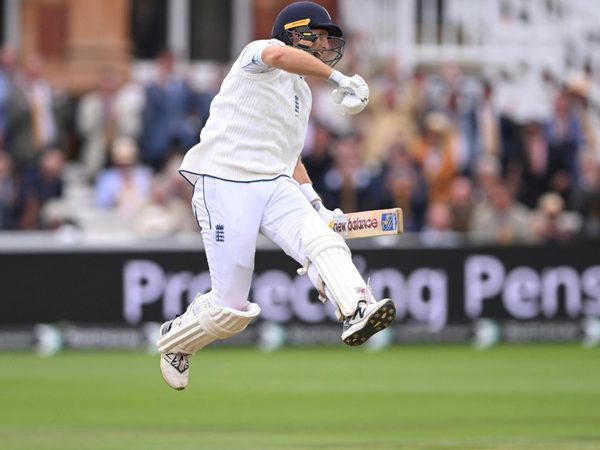
Jack Leach broke through Pakistan’s top order in the third innings in Karachi, taking three wickets in six balls. He has been impressive on this tour, but the success of Rehan Ahmed and Will Jacks has given England other options to think about, writes Katya Witney.
All three of Jack Leach’s wickets on the third morning at Karachi were textbook left-arm spin dismissals. The first two came from balls that turned sharply, drawing both Shan Masood and Azhar Ali onto the front foot before spinning past the bat and lighting up the zing bails. The third, which put him on a hat-trick, straightened beautifully to deceive Abdullah Shafique for the second time in the match, pinning him plumb lbw. In the space of six balls, he had upended Pakistan from looking relatively comfortable at 53-0 to teetering on the verge of another collapse at 54-3.
This tour marks the culmination of Leach’s best year yet in Test cricket. It’s the first year he’s played in every single Test match England have contested, and he currently sits at the top of the 2022 wicket-taking charts, albeit with England having played the most Tests of any team this year. He has a lower economy rate (2.89) than in any year since 2018, his first in Test cricket, and taken two five-fors as well as his maiden ten wicket-haul for England. In the second Test of the series in Pakistan, he became the 20th male spinner to take 100 Test wickets for England. He has achieved plenty, and has lots to be proud of.
Much of this can be put down to the injection of positive intent Brendon McCullum and Ben Stokes have instilled into the side they took over in June, giving Leach the clarity over his role in the side he had lacked under Joe Root. In a way, his is the traditional spinners’ role, but there is some added Stokesian aggression. He still needs to keep things tight early in the game and threaten more when the surface breaks up, but even in the first innings, there is an emphasis on attack. This is best shown by his first-innings five-for at Headingley in the summer, with Stokes refusing to push Jonny Bairstow back to the rope, and Leach enticing Neil Wagner to hit him next ball. His confidence is seemingly increasing with every match he plays, and for now Stokes trusts him, with Leach opening the bowling five times under his captaincy.
Leach endured a difficult tour of Australia, playing three matches as England tried to negotiate their way through the second and fifth Tests without a frontline spinner. Having struggled to take wickets and contain runs in the Ashes, he has made a remarkable turnaround. Picked for the first home Test of the summer before suffering a concussion in the field, he took his first ten-wicket haul just three weeks later at Headingley.
Now in Pakistan, he is England’s leading wicket-taker and has done a good job of leading a young spin attack as the only specialist spinner on the tour. He has managed not to let Pakistan’s batters get too heavily on top of him while also often looking threatening with his turn and angle.
But, there is a but. Leach has many qualities, and has rarely let England down. However, their approach to the second-spinner role on this tour, using a hybrid No.8 – more than a part-timer but also in the XI – has left them with a relatively unfamiliar selection dilemma. It’s not about picking the best spinner, it’s about deciding what role fits their style of cricket the best.
A few hours after Leach’s early triple-strike, Rehan Ahmed became the youngest England men’s bowler ever to take a Test five-wicket haul. Just as pertinently for Leach, he’s the first English spinner to take a five-for on debut since Will Jacks did it two weeks ago. Both Jacks and Ahmed were promoted up the order to No.3 as pinch-hitters in scenarios where England wanted quick runs. Selecting both of the youngsters has given England the flexibility to continue their aggressive approach with the bat, whilst not compromising their bowling options by giving up another space in the XI to a specialist spinner. While Leach was to the fore against New Zealand, against India and South Africa, he was tasked with bowling more than 20 overs in an innings just once, and claimed three wickets in four games – would England have preferred another ball-striker who could fill in when needed?
Both of Ahmed and Jacks have shown promise with the ball, particularly the former. There were times during both innings in Karachi where Ahmed looked the most threatening bowler in England’s attack, while Jacks benefitted from the batters having put such a huge total on the board in the first Test, but only bowled eight overs in the second. Joe Root’s role also shouldn’t be overlooked on this tour: he has contributed five wickets from the 63 overs he’s bowled at a better economy rate than any of the other England spinners.
Leach has looked the most complete and consistent of England’s spin attack in Pakistan, as you would expect. He’s bowling as well as ever before and is clearly a very popular member of the squad. But, in a team that looks to try and score 167 runs in less than an hour to win the Test match on day three, does his role – rather than him as a player – give added value to the side outside of spinning conditions?
If England are going to go out all guns blazing with the bat and score as quickly as they have been doing, as well as backing themselves to chase any total asked of them, does it matter whether Leach goes at 2.9 an over, or if Jacks or Ahmed leaks 3.5? If Root can also share the spin duties with whoever England’s No.8 is, that could be sufficient for England in New Zealand in February, or on home soil against Australia.
In normal circumstances, England wouldn’t consider dropping Leach. He has done an impressive job for them since McCullum took over and on this tour. But normal circumstances don’t include a teenager taking five wickets in his first Test and then coming out to bat at No.3. They don’t include Jacks taking his first-ever first-class five-for in a Test match. And they don’t include a batting side that views four an over as slow going. Leach has done very little wrong, and England will almost certainly retain him for the Test series against New Zealand. But Ahmed and Jacks’ performances, as well as the continued success of their hyper-aggressive mentality, has given England other options to think about.








